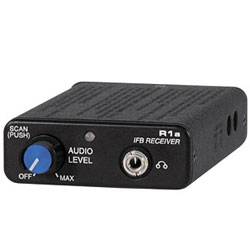|
ASC (Canada) Ltd. Phone: 416-251-5409 Sales Rentals Service Carts & Custom Work Specials Consignment Used Goods Downloads Links Contact Us |
|
R1a
A special button push sequence is required to set the receiver into the scanning mode to prevent accidental changes to the receiver memory. Simplified instructions are laser engraved into the housing of the receiver. The scanning process is performed at two different sensitivity levels. The first scan is performed at a reduced sensitivity to avoid falsely locking onto IM (intermodulation) signals rather than true carriers. This reduced sensitivity scan is necessary when the unit is programmed in close proximity to the transmitter. If no signals are found in the first scan, a single button push will set the receiver to full sensitivity and begin a second scan. Full sensitivity scanning is necessary to program the receiver at a distance away from the transmitter. The design uses +/-20 kHz FM deviation for efficient use of the bandwidth, with compandor noise reduction circuitry for an excellent signal to noise ratio. A supersonic Pilot Tone signal controls the audio output squelch to keep the receiver silent when no transmitter signal is received. The receiver operates on a single 9 volt alkaline or lithium battery. Alkaline battery life is up to 8 hours. Lithium battery life is well over 20 hours. The LED indicator changes color from green, to yellow, to red as the battery voltage declines to provide plenty of warning before operation ceases. An internal relay in the receiver will automatically detect a monaural plug connected to the output jack and switch accordingly. Full output power is available with either type of connector, without the power losses that result from a resistive circuit design. The antenna input is provided by the shield of the cable and headset or earphone connected to the output jack. The receiver will drive a wide variety of earbuds, headphones and induction neck loops at substantial levels, with loads from 16 Ohms to 600 Ohms. The receiver is housed in a rugged machined aluminum package. A spring-loaded belt clip is available as an accessory which provides a secure mounting on a wide variety of belts, pockets and fabrics. The incoming RF signal is filtered and amplified, then mixed down to the IF frequency with a microprocessor controlled synthesizer. A pilot tone squelch system is used to keep the receiver silent when no carrier is present. The pilot tone signal is on a different frequency than Lectrosonics UHF wireless microphone systems to prevent interference when the systems are used in the same location. The audio signal processing includes compandor noise reduction for low noise and excellent intelligibility. The receiver is housed in a compact machined aluminum enclosure. The unit features an integral rotating battery door that remains attached to the housing when opened. All nomenclature is laser engraved into the housing to withstand physical abrasion and heavy use. A condensed instruction set is also laser etched into the side panel of the receiver.
Block 470 470.100 - 495.600 Block 19 486.400 - 511.900 Block 20 512.000 - 537.500 Block 21 537.600 - 563.100 Block 22 563.200 - 588.700 Block 23 588.800 - 607.900 and 614.100 - 614.300 Block 24 614.400 - 639.900 Block 25 640.000 - 665.500 Block 26 665.600 - 691.100 Block 944 944.100 - 951.900
Frequency control: Crystal Controlled PLL |
